This article needs additional citations for verification .(September 2014) |

A tram engine is a steam locomotive specially built, or modified, to run on a street, or roadside, tramway track.
This article needs additional citations for verification .(September 2014) |

A tram engine is a steam locomotive specially built, or modified, to run on a street, or roadside, tramway track.

In the steam locomotive era, tram engines had to comply with certain legal requirements, although these varied from country to country:
To avoid smoke, the fuel used was coke, rather than coal. To prevent visible emission of steam, two opposite systems were used:
The Great Eastern Railway built ten Class G15 0-4-0T trams from 1883 to 1897 and twelve Class C53 0-6-0T trams from 1903 to 1921.
Beyer, Peacock & Company built some steam tram engines, including three for the Glyn Valley Tramway in Wales.
Hughes's Locomotive & Tramway Engine Works, Loughborough started building tram engines in 1876. His engines were of the saddle-tank type and exhaust steam was condensed in a tank under the footplate by jets of cold water from the saddle-tank.
Kitson & Company started to build tram engines in 1878. It used a roof-mounted, air-cooled, condenser of thin copper tubes in which the exhaust steam was condensed, similar to the radiator on a modern road vehicle. The air-cooled system eventually became standard for steam tram engines.
William Wilkinson of Holme House Foundry, Wigan patented the exhaust steam reheating system about 1881. While it may seem unusual to re-heat steam after, rather than before, use because it would involve a waste of fuel, the purpose of superheating the exhaust was to ensure 'no water can be emitted from the chimney to the annoyance of passengers'. Furthermore, the expansion into a hot chamber in the boiler minimised the noise of the exhaust. [1] Despite the inefficiency inherent in this, the Wilkinson system was popular for a time, and engines of the Wilkinson type continued to be built up to about 1886. Similar reheaters were also used for road steam wagons, such as the Sentinel.
Other British builders of steam tram engines included:
The German firm Krauss built steam tram engines, including one for the Wolverton and Stony Stratford Tramway in England.

From the 1880s onward, every steam locomotive builder in Belgium supplied the National Company of Light Railways (SNCV in French) with tram engines, with nearly 1,000 examples being built. Ateliers de Tubize, FUF Haine-Saint-Pierre and Société de Saint-Léonard also supplied several tram engines to foreign companies such as Spain, the Netherlands, France, or Italy.
The last steam trams were delivered in the early 1920s.

Corpet-Louvet, Décauville, Pinguely, and Blanc-Misseron built engines for French and foreign tramways, the latter was created by Ateliers de Tubize in order to avoid taxation of imported locomotives. These companies also built industrial engines and some shunters; large steam locomotives were mostly built by other companies.
Werkspoor and Backer & Rueb built engines for both Dutch and foreign tramways.

The Baldwin Locomotive Works in Philadelphia, Pennsylvania, USA, built steam tram engines, including most of those used in New South Wales, Australia.
A small number of steam tram engines were manufactured in Sydney, Australia to Baldwin designs by Henry Vale, T. Wearne and the Randwick Tramway Workshops.
In cities, steam tram engines faded out around 1900, being replaced by electric trams or buses. Rural steam trams held longer until replaced by electric, diesel trams units or buses. In France, The Netherlands and Belgium, the last steam-powered tram lines closed in the 1960s.
The character Toby the Tram Engine, from The Railway Series children's books by the Rev. W. Awdry, and the spin-off TV series Thomas & Friends, was based on the LNER Class J70 tram engines that were to be found on the Wisbech and Upwell Tramway.
Flora from Series 12 of Thomas & Friends is also based on a steam tram.

Four of the British Rail Class 04 diesel locomotives were fitted with side-plates and cowcatchers for working on the Wisbech and Upwell Tramway.
There are a few examples of electric tram locomotives designed to pull traditional railway carriages through streets.
Tram engines have been built to run on stored energy in various forms, including:

A Garratt locomotive is a type of steam locomotive invented by British engineer Herbert William Garratt that is articulated into three parts. Its boiler, firebox, and cab are mounted on a centre frame or "bridge". The two other parts, one at each end, have a pivot to support the central frame; they consist of a steam engine unit – with driving wheels, trailing wheels, valve gear, and cylinders, and above it, fuel and/or water storage.
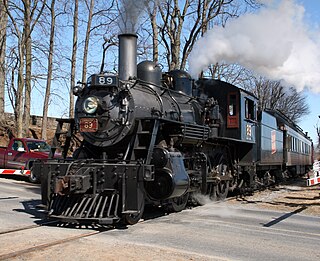
Under the Whyte notation for the classification of steam locomotives, 2-6-0 represents the wheel arrangement of two leading wheels on one axle, usually in a leading truck, six powered and coupled driving wheels on three axles and no trailing wheels. This arrangement is commonly called a Mogul.

Under the Whyte notation for the classification of steam locomotives, a 2-6-4 locomotive has two leading wheels, six coupled driving wheels and four trailing wheels.
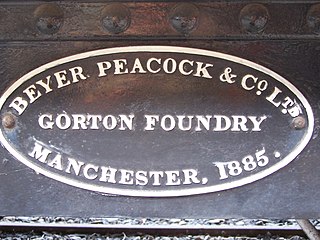
Beyer, Peacock and Company was an English railway locomotive manufacturer with a factory in Openshaw, Manchester. Founded by Charles Beyer, Richard Peacock and Henry Robertson, it traded from 1854 until 1966. The company exported locomotives, and machine tools to service them, throughout the world.
Kitson and Company was a locomotive manufacturer based in Hunslet, Leeds, West Yorkshire, England.

A condensing steam locomotive is a type of locomotive designed to recover exhaust steam, either in order to improve range between taking on boiler water, or to reduce emission of steam inside enclosed spaces. The apparatus takes the exhaust steam that would normally be used to produce a draft for the firebox, and routes it through a heat exchanger, into the boiler water tanks. Installations vary depending on the purpose, design and the type of locomotive to which it is fitted. It differs from the usual closed cycle condensing steam engine, in that the function of the condenser is primarily either to recover water, or to avoid excessive emissions to the atmosphere, rather than maintaining a vacuum to improve both efficiency and power.
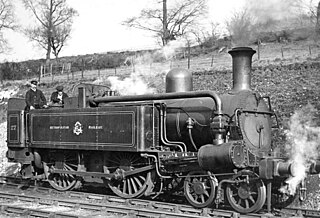
The Metropolitan Railway A Class and B Class were 4-4-0T condensing steam locomotives built for the Metropolitan Railway by Beyer Peacock, first used in 1864. A total of 40 A Class and 26 of the slightly different B Class were delivered by 1885. Used underground, the locomotives condensed their steam, and coke or smokeless coal was burnt to reduce the smoke.

Under the Whyte notation for the classification of steam locomotives, 2-6-0+0-6-2 represents the wheel arrangement of an articulated locomotive with two separate swivelling engine units, arranged back to back with the boiler and cab suspended between them. Each engine unit has two leading wheels in a leading truck, six powered and coupled driving wheels on three axles and no trailing wheels.

Thomas Green & Son, Ltd. were engineers who manufactured a wide range of products at the Smithfield Foundry, Leeds, United Kingdom

Under the Whyte notation for the classification of steam locomotives, 0-6-0+0-6-0 represents the wheel arrangement of an articulated locomotive with two separate swivelling engine units, each unit with no leading wheels, six powered and coupled driving wheels on three axles and no trailing wheels. The arrangement is effectively two 0-6-0 locomotives operating back-to-back and was used on Garratt, Double Fairlie, Meyer and Kitson-Meyer articulated locomotives. A similar arrangement exists for Mallet steam locomotives on which only the front engine unit swivels, but these are referred to as 0-6-6-0.
The Musée des tramways à vapeur et des chemins de fer secondaires français is located alongside Valmondois railway station, in the small town of Butry-sur-Oise in the departement of Val-d'Oise, 30 kilometres (19 mi) north of Paris.
The museum houses a collection of railway vehicles from the former French departmental railways, preserved, restored and rebuilt by the members of an association. During the season, short trips can be made on some of the exhibits, at a separate location in the town of Crèvecoeur le Grand, along a metre gauge line, three kilometers in length, nicknamed the "Impressionists' railway".

There are currently no functioning railways in Haiti, and there have never been any rail connections with the neighbouring Dominican Republic. However, between 1876 and the 1970s, various tramways and railways ran in the country. A tram network operated in the capital, Port-au-Prince, between 1897 and 1932. Three railway lines, along with some industrial lines, constituted the Haitian national rail network. The first horse drawn street tramway opened in 1876, with rural railways constructed later.
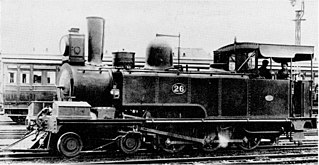
The South African Railways Class C 4-6-0T of 1879 was a steam locomotive from the pre-Union era in the Colony of Natal.

The 3 ft narrow gauge Portstewart Tramway operated tramway services between Portstewart and Portstewart railway station at Cromore from 1882 to 1926.
The Tramway Historical Society Inc. is located at the Ferrymead Heritage Park in the Christchurch, New Zealand suburb of Ferrymead and operates the standard gauge Ferrymead Tramway. Trams have operated at Ferrymead since 1968, with progressive extensions built between 1970 and 1984 allowing trams to operate within the boundaries of the Heritage Park. The Society also operates and own a collection of historic trolley buses and diesel buses.

The Sydney Steam Motor Trams were built for and operated by the New South Wales Government Tramways of Australia.

The Cape Government Railways 1st Class 2-6-0 of 1876 by Kitson was a South African steam locomotive from the pre-Union era in the Cape of Good Hope.
The Chemin de fer à vapeur des Trois Vallées is a heritage railway in southern Belgium, created in 1973.
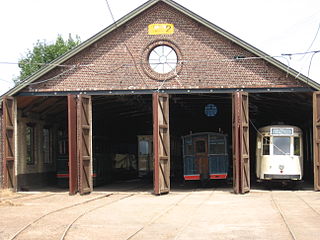
The Tramsite Schepdaal is a tramway museum in Schepdaal, located in the Belgian municipality Dilbeek, west of Brussels